When deciding between bagged and bagless vacuums, consider their pros and cons. Bagged models trap allergens better and require less maintenance, but you’ll face ongoing bag costs. Bagless vacuums save money on bags and are eco-friendly, yet they need regular cleaning and can release dust when emptied. Weighing these factors can help you make the best choice for your home cleaning needs. There’s plenty more to uncover about these two options.
Key Takeaways
- Bagged vacuums trap allergens effectively with sealed bags and HEPA filters, enhancing indoor air quality, especially in homes with pets.
- Bagless vacuums eliminate ongoing bag costs, offering long-term savings despite potentially higher initial prices.
- Bagged vacuums require less maintenance due to sealed bags, while bagless models need frequent cleaning of filters and dust cups.
- Emptying bagless vacuums can release dust back into the air, whereas bagged vacuums minimize contact with allergens during disposal.
- Environmental concerns arise from disposable bags contributing to landfill waste, while bagless vacuums are more eco-friendly with reduced overall waste.
Overview of Bagged Vacuum Cleaners

When it comes to vacuuming, bagged vacuum cleaners offer a reliable solution for maintaining clean indoor air.
These vacuums utilize disposable bags to collect dust and debris, ensuring that clean air passes through as the bag fills up. Many bagged models come equipped with high-efficiency particulate air (HEPA) filters, which can trap 99.9% of allergens, greatly improving your indoor air quality. Furthermore, they are often praised for their strong suction capabilities, making them effective at removing dirt and pet hair from various surfaces. Regularly replacing the bags is essential for optimal performance, ensuring that the vacuum continues to operate efficiently. Additionally, regular maintenance plans can further enhance their efficiency and lifespan. Bagged vacuums are also known for their high filtration efficiency, making them suitable for allergy sufferers.
The process of removing and replacing the bags is generally mess-free, minimizing your direct contact with dirt and allergens. Plus, bagged vacuums tend to require less frequent maintenance than bagless models, as they don’t need regular filter cleaning and often have larger dirt capacities.
This makes them a practical choice for busy households. Additionally, their designs often include multi-surface capability, allowing for efficient cleaning across different floor types.
Pros of Bagged Vacuum Cleaners
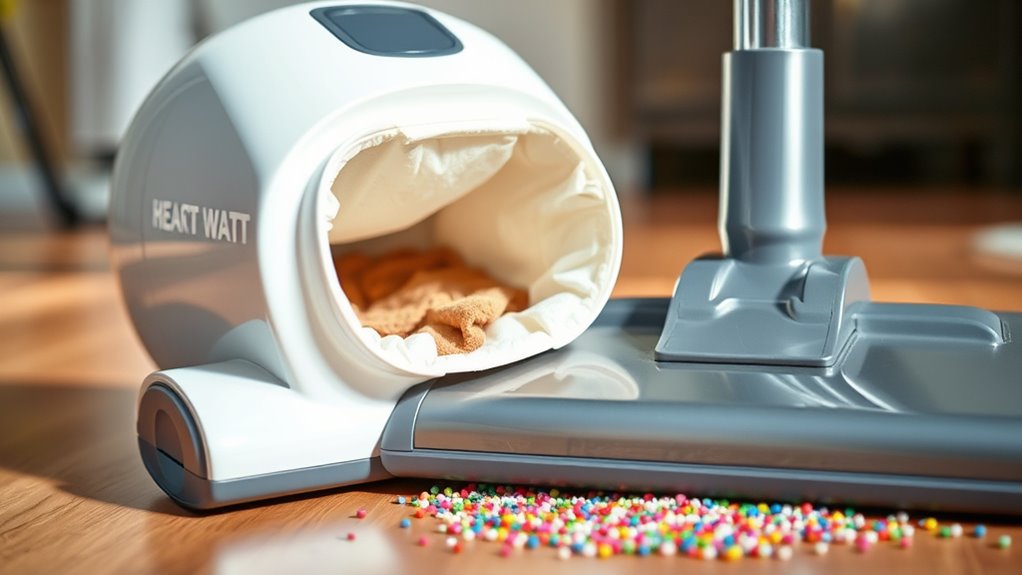
Bagged vacuum cleaners boast several advantages that make them a smart choice for many households.
For allergy sufferers, these vacuums minimize contact with dust and allergens during disposal, thanks to sealed bags that contain debris effectively. Many bagged vacuums come equipped with HEPA filters, trapping up to 99.9% of allergens, making them ideal for homes with pets. Additionally, these models often feature advanced cleaning technology that enhances their ability to capture fine particles and maintain air quality. Furthermore, regular maintenance practices, such as improving ventilation, can further boost the overall air quality in your home. Studies indicate that using air purifiers alongside bagged vacuums can significantly enhance indoor air quality, particularly through pollutant reduction.
Bagged vacuum cleaners are perfect for allergy sufferers, effectively trapping allergens and minimizing dust exposure during disposal.
You’ll find that bagged models typically require less maintenance, as the sealed bags reduce the need for frequent filter cleaning. Additionally, the larger capacity of the bags allows for longer usage periods before replacement, enhancing convenience.
Finally, bagged vacuums often deliver superior deep cleaning performance, ensuring your carpets remain free from dirt and allergens. Regular maintenance, such as filter cleaning and inspecting for blockages, can further improve their efficiency and lifespan.
Cons of Bagged Vacuum Cleaners
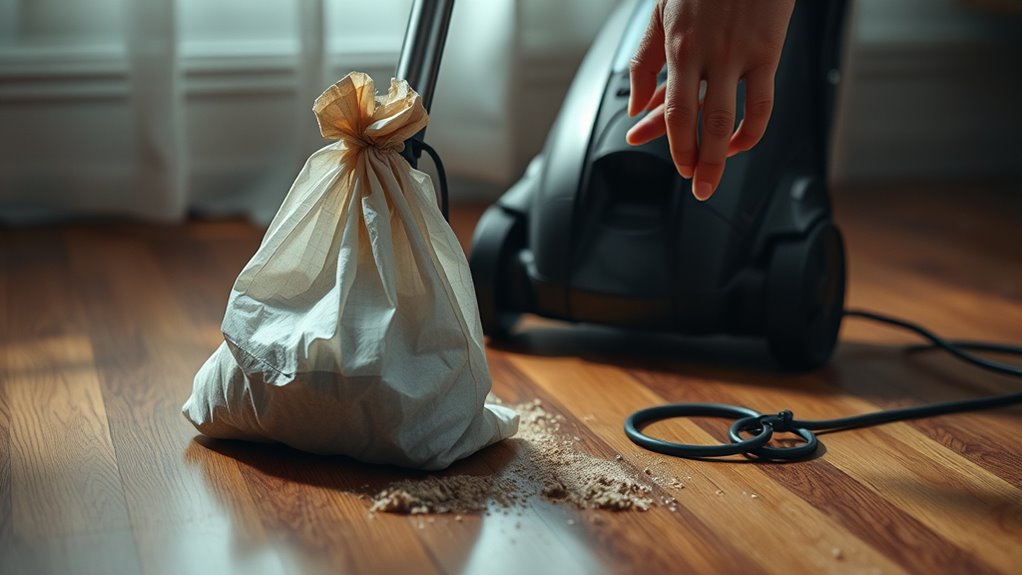
While bagged vacuum cleaners can be convenient, they come with ongoing costs due to the need for replacement bags, which can add up over time. You might also find yourself concerned about the environmental impact, as these disposable bags often contribute to landfill waste. Plus, as bags fill up, you may notice a drop in suction power, making your cleaning less effective. Additionally, advanced filtration systems are often more effective in bagless models, which can enhance allergen reduction in your home. Moreover, using high-fiber foods in your diet can further support respiratory health, making it important to consider all aspects of your cleaning and health regime. Maintaining a clean environment can also help in reducing stress levels, contributing to overall mental well-being. Furthermore, incorporating leafy greens into your diet can promote cognitive function, which is essential for maintaining focus while cleaning. Understanding the importance of financial planning for ongoing costs can help you make a more informed decision about your vacuum cleaner choice.
Ongoing Bag Costs
One significant drawback of bagged vacuum cleaners is the ongoing cost of replacement bags. These costs can accumulate quickly, especially in homes with lots of dirt. You might spend anywhere from $10 to $30 for a pack of bags, adding to your long-term expense. Depending on your usage, you could find yourself replacing bags every 1-3 months, leading to an annual cost of $40 to $120. Plus, if your vacuum lacks a fullness indicator, you might face unplanned expenses when you realize you need more bags. Additionally, regular maintenance of your vacuum cleaner, including checking filter indicators, can help you avoid unexpected costs associated with bag replacements. Having a clear understanding of your budget can also help you manage these ongoing expenses effectively. Furthermore, investing in a vacuum with a high filtration system can enhance air quality by trapping allergens, which is an important consideration for households with sensitivities. It’s essential to research companies thoroughly to find a vacuum that suits your needs without incurring excessive long-term costs. Additionally, understanding the routine health checks for your vacuum can prevent problems that lead to further expenses and ensure optimal performance.
| Frequency of Replacement | Cost per Pack | Annual Cost Estimate |
|---|---|---|
| Every 1 month | $20 | $240 |
| Every 2 months | $20 | $120 |
| Every 3 months | $20 | $80 |
| Every 1 month | $10 | $120 |
| Every 2 months | $10 | $60 |
Environmental Waste Concerns
When considering the environmental impact of your cleaning choices, it’s clear that bagged vacuum cleaners can considerably contribute to waste.
Here are three key concerns:
- Disposable Bags: Most disposable bags are made from non-recyclable materials, leading to significant landfill accumulation. Additionally, the production of these bags can have a negative impact on air quality indicators, which is a concern for both health and the environment.
- Replacement Bags: The ongoing need for replacement bags adds to your environmental footprint, as each purchase requires more resources for production and disposal. This cycle of consumption can be particularly detrimental to sustainable living practices. Furthermore, the production of disposable bags can contribute to carbon emissions that exacerbate climate change.
- Sourcing Eco-Friendly Options: Finding eco-friendly bags can be challenging, making it tough for environmentally conscious consumers to mitigate waste.
Given these factors, bagged vacuums may not be the best choice if you’re looking to reduce your environmental impact. Additionally, the production and disposal of these bags contribute to deforestation and climate change, exacerbating the overall environmental crisis.
Opting for bagless options could help you minimize waste and promote a more sustainable cleaning routine.
Overview of Bagless Vacuum Cleaners
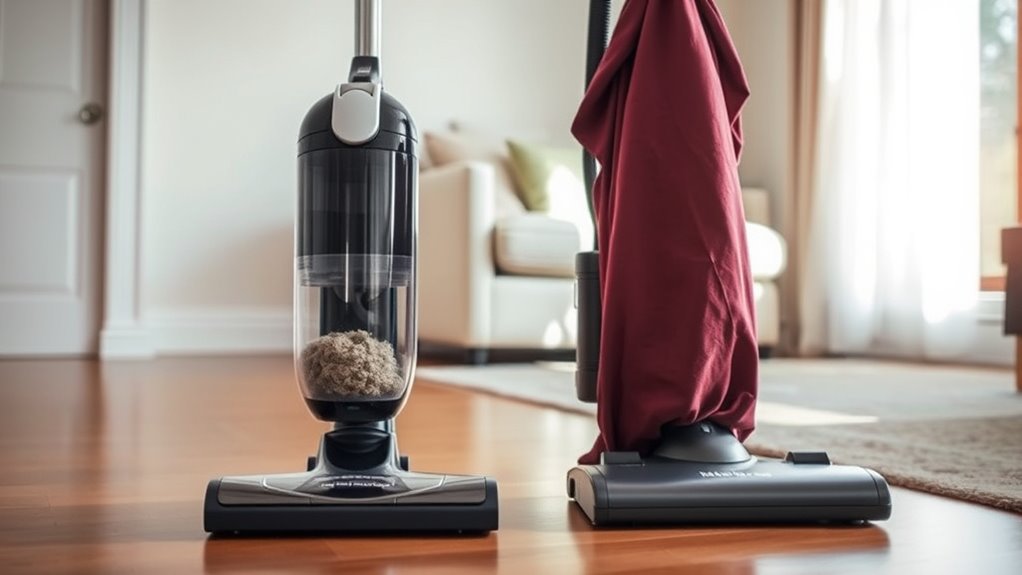
Bagless vacuum cleaners have gained popularity for their convenience and eco-friendly design. These models utilize a dust cup to collect dust and debris without the hassle of disposable bags. This means you won’t need to purchase replacements, making them cost-effective in the long run. With transparent dust compartments, you can easily see when it’s time to empty the bin. While bagless vacuums eliminate the waste of bags, maintenance for bagless vacuums requires regular cleaning of filters that need attention to maintain peak performance. Some vacuum models even come with innovative features like hands-free emptying, which adds to user convenience.
| Feature | Description |
|---|---|
| Dust Cup | Collects dirt without bags |
| Transparent Compartment | Easily see when to empty |
| Maintenance | Regular filter and cup cleaning |
Pros of Bagless Vacuum Cleaners

When you choose a bagless vacuum cleaner, you can save money over time by skipping the expense of replacement bags.
Plus, their eco-friendly design helps reduce waste, making your cleaning routine a bit greener.
With user-friendly features like clear dust cups and lightweight designs, bagless vacuums make maintenance and maneuvering around your home a breeze.
Cost Savings Over Time
While you might pay more upfront for a bagless vacuum, the long-term savings can make it a smart choice.
Here are three cost-saving benefits to contemplate:
- No Replacement Bags: Bagless vacuums eliminate the need for buying replacement bags, reducing your long-term expenses considerably.
- Lower Maintenance Costs: You’ll only need to think about filter replacements, which can range from $3 to $36, often cheaper than multiple bags over time.
- Ideal for Households with Pets: If you have pets, you can empty the dust container without incurring extra costs, maximizing your savings.
Ultimately, investing in a bagless vacuum can lead to substantial cost savings, making it a wise choice for many households.
Eco-Friendly Design Benefits
Choosing a bagless vacuum can greatly benefit the environment. By eliminating the need for disposable bags, you greatly reduce the waste generated during vacuuming. This eco-friendly design appeals to those who are conscious of their environmental footprint.
Many bagless models come with reusable filters that you can clean instead of replacing, further minimizing waste. The transparent canister allows you to see collected dirt and debris, encouraging timely emptying and preventing clogged filters.
Plus, bagless vacuums often use cyclonic technology, enhancing efficiency while avoiding additional disposable materials. By opting for a bagless vacuum, you’re contributing to less accumulation of non-recyclable waste in landfills, making an eco-friendly choice that benefits both your home and the planet.
User-Friendly Features
Bagless vacuums not only offer eco-friendly benefits but also come packed with user-friendly features that make cleaning a breeze.
Here are three standout aspects you’ll appreciate:
- Transparent Dust Cup: You can easily see when it’s time to empty, promoting timely maintenance without guesswork.
- One-Touch Emptying Systems: Many bagless models minimize mess and simplify the disposal process, keeping your hands clean.
- Washable Filters: These reusable filters save you money over time, reducing the need for frequent replacements.
Plus, advanced cyclonic technology in some models maintains suction power and prevents clogging.
With their lightweight and often cordless design, bagless vacuums deliver unmatched ease and efficiency compared to traditional bagged vacuums.
Cons of Bagless Vacuum Cleaners
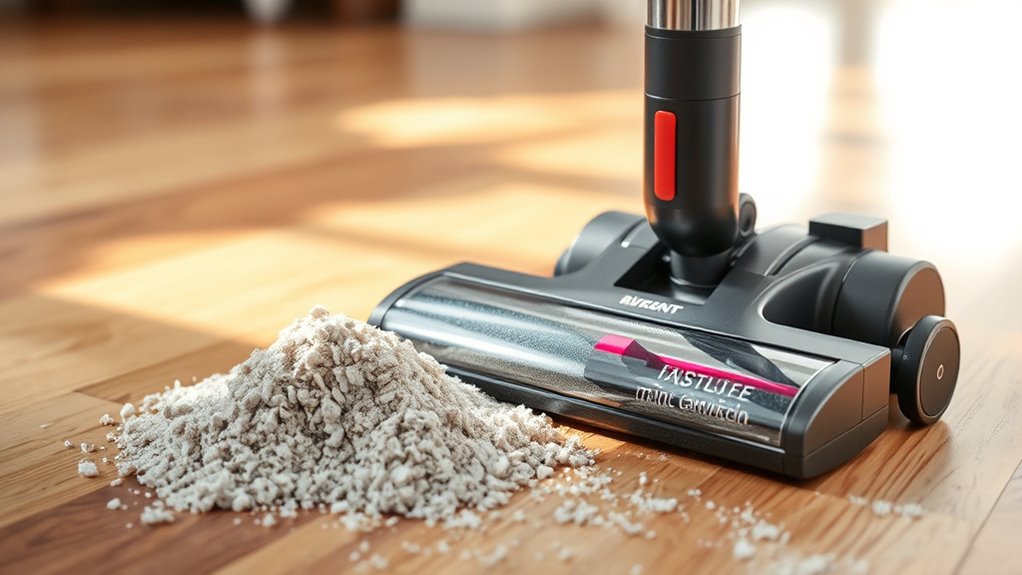
Although bagless vacuum cleaners offer convenience, they come with several drawbacks that can affect your cleaning experience.
One major issue is the emptying process, which can release dust and allergens back into the air, potentially worsening indoor air quality and your allergies.
Additionally, these vacuums require frequent maintenance, including regular cleaning of filters and dust cups, which can be time-consuming.
The dustbin can also be messy to empty, with dirt spilling if you’re not careful.
Dust and debris tend to accumulate in various parts of bagless vacuums, necessitating regular washing to maintain peak performance.
If you neglect filter maintenance, you might experience reduced suction power, leading to decreased cleaning efficiency.
Cost Considerations for Bagged vs. Bagless

When weighing the costs of bagged versus bagless vacuums, it’s essential to evaluate both upfront and long-term expenses.
Here are three key points to take into account:
- Upfront Costs: Bagged vacuums generally have a lower initial price, but you’ll face ongoing expenses for replacement bags.
- Long-Term Costs: Bagless vacuums eliminate the need for bags, providing savings over the lifespan, despite potentially higher upfront costs.
- Maintenance Requirements: Both types require maintenance, but bagless models may need HEPA filter replacements, which can range from $3 to $36.
Ultimately, understanding the total cost of ownership will help you make an informed decision that fits your budget and cleaning needs.
Performance and Maintenance Comparisons
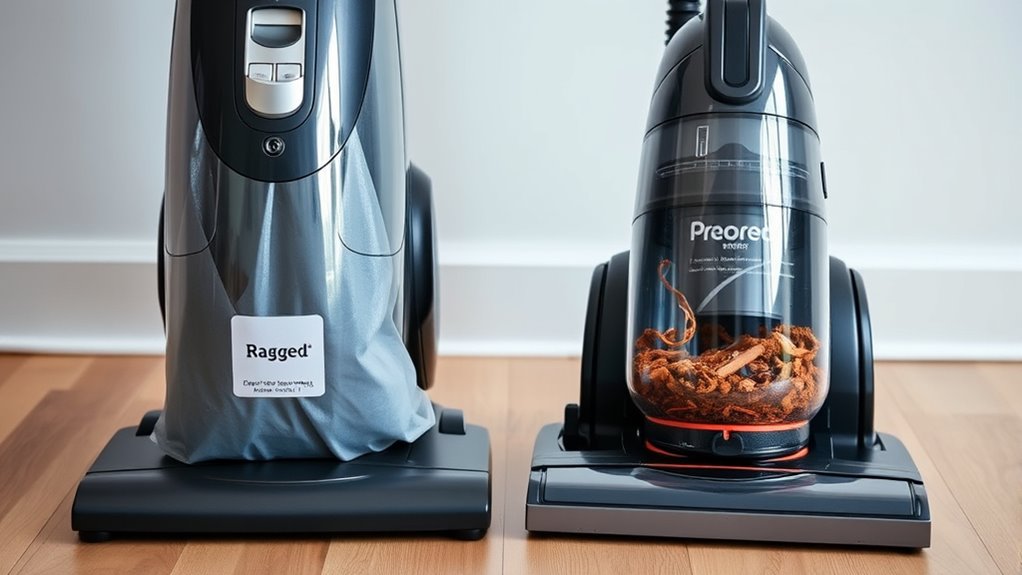
While both bagged and bagless vacuums have their merits, their performance and maintenance needs can greatly impact your cleaning experience.
Bagged vacuums excel in suction power, maintaining consistent performance even as bags fill up. They effectively trap dirt and allergens, making them ideal for deep cleaning carpets.
In contrast, bagless vacuums may lose suction if the dust container isn’t emptied regularly, and they require frequent filter cleaning to prevent clogging, which can be time-consuming. Although bagless models eliminate the need for disposable bags, the ongoing maintenance can be a hassle.
Ultimately, if you prioritize superior performance with less maintenance, bagged vacuums might be the better choice for you.
Frequently Asked Questions
Is It Better to Have a Bagged or Bagless Vacuum?
When deciding whether a bagged or bagless vacuum is better for you, think about your cleaning needs.
If you’re concerned about allergens, a bagged vacuum might suit you better due to its sealed bags.
However, if you prefer convenience and want to avoid buying replacement bags, a bagless vacuum could be the way to go.
Consider your budget, maintenance preferences, and how often you clean to make the best choice for your home.
Which Vacuum Cleaner Is Best, With Bag or Without Bag?
When you’re choosing a vacuum cleaner, considering your specific needs is essential.
If you prioritize allergen control and consistent suction, a bagged vacuum might be your best bet.
However, if you prefer convenience and lower long-term costs, a bagless model could work better for you.
Ultimately, think about how often you’ll clean, your budget, and any allergies.
Each type offers unique benefits that cater to different lifestyles and preferences.
What Are the Disadvantages of a Bagless Vacuum Cleaner?
When you use a bagless vacuum cleaner, you might face some drawbacks.
Emptying the dust bin can release allergens back into the air, which isn’t great if you have allergies.
Plus, you’ll need to clean and maintain filters and dust cups regularly, adding to your workload.
As the dust container fills, you could notice a loss in suction power, which might affect how effectively you clean your home.
Do Bagged Vacuums Lose Suction?
Think of a bagged vacuum as a well-tuned engine, consistently delivering power until it reaches its limit.
Generally, bagged vacuums don’t lose suction until the bag is completely full. As long as you keep an eye on the bag, you’ll maintain strong suction and efficient cleaning.
Many models even have indicators to alert you when it’s time to change the bag, ensuring you can manage performance effectively and keep your space spotless.
Conclusion
In the battle between bagged and bagless vacuums, each has its merits. You might appreciate the convenience and cost-effectiveness of bagless models, yet find the superior filtration and hassle-free disposal of bagged options hard to ignore. While bagless vacuums let you see the dirt, bagged ones can keep allergens contained. Ultimately, it boils down to your cleaning style and preferences—choose the one that fits your needs, and enjoy a cleaner home without compromise.









